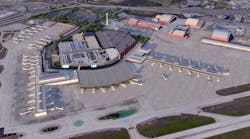... the letter of March 6 begins. It is signed by 35 industry trade groups, and opens: “As representatives of the aviation community, we are writing to stress the importance of passing a comprehensive, long-term reauthorization of the Federal Aviation Administration.†Good luck.
Scott Weaver, vice president of government affairs for Airports Council International-North America, explains, “The idea behind it was, though all these associations have different issues and priorities, we could all agree that we need a bill this year.†Unfortunately, funding legislation for FAA and the U.S. aviation system remains at an impasse, bottled up primarily over disagreement on what taxes to charge and the ongoing feud between the agency and the controllers union, NATCA, which signed the letter.
A common complaint from Capitol Hill is that aviation groups too often come to Congress with their parochial interests and without a common message. The letter serves to address that concern. Problem is, both AOPA and ATA declined the invitation to be signees to ‘the letter’ ... they represent the two opposing sides. When funding aviation, AOPA wants to change little; ATA wants to change everything – and have a hand in the future control of the system. In the middle sits the airport community and the FAA’s airports division; reliable funding streams and infrastructure investment are the desired goals here.
Weaver notes that FAA is now disseminating AIP monies to airports, but is limited to 75 percent of that appropriated, and is only authorized to do so through June. He adds that it's the smaller commercial airports that are being hardest hit. Some examples from ACI-NA ...
-- Quad City International Airport - Moline, IL
A $3 million project will be used to replace concrete panels on the primary 10,000-foot air carrier runway. This project is a phased project over a three-year period, so funding is critical to keep the project moving. Without panel replacement, the runway will continue to deteriorate, which could force air carriers to use other, shorter runways and that could affect the number of seats offered on those aircraft.
A second project for $2 million will start the dirt work for a new taxiway/temporary runway. Both projects are being done in conjunction with each other for a four-year construction period with the total AIP cost of just over $27 million. Both projects are anticipated to be on the State of Illinois’ spring bid-letting so they can be started during this upcoming summer construction season. Without AIP funding, both projects will be a no-go.
-- Pensacola (FL) Regional Airport
The airport is delaying construction of an $8 million apron expansion project that is part of a $75 million airport capital program. The delay has caused the airport and its construction team to reschedule the timing of the apron work with the expansion of the terminal concourse.
-- Fresno (CA) Yosemite International Airport
Officials have been advised not to count on any discretionary funding for FY2008. The airport’s short- and long-term capital improvement program is based on a FAA-approved pavement management program that identifies the timing of when taxiways and runways are required to be rehabilitated and extended. The work is in priority order, so delayed funding delays all projects in subsequent years.
A final comment from ACI-NA’s Weaver: “Things don’t look too sunny right now, but we’re going to keep fighting. Realistically, if anything is going to happen it’s going to happen before summer recess.â€
Thanks for reading. jfi



